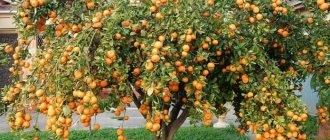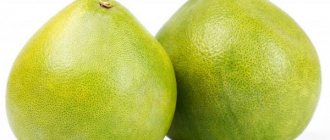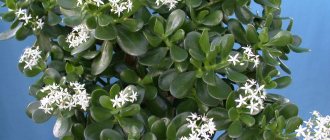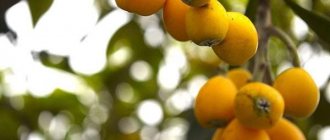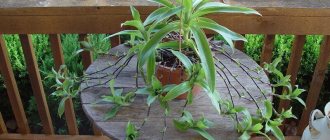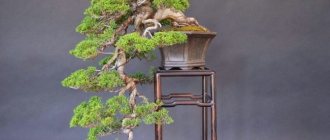Is it possible to germinate tangerines from seeds at home?
Growing a tangerine at home is not difficult if you know how a tangerine grows and what conditions it needs:
- Frequent watering will help build strong immunity, prevent diseases, ensure rapid growth and good fruiting.
- Annual replanting is a prerequisite for caring for tangerines. If the roots are cramped in the container, the tree will stop developing.
- Fertilizing is necessary in order to improve the quality and taste of the fruit.
. A tangerine in a tub is not only a healthy and tasty citrus, but also a beautiful indoor plant
In “captivity” conditions, the tree reaches 1.5 m. How long a tangerine tree grows depends on how well it is cared for.
Note! In the wild, the lifespan of a mandarin is approximately 15-20 years. An indoor tree will live the same amount of time if it is comfortable.
Properties of tangerine - harm and benefit
Beneficial features
What are the benefits of tangerine? Tangerine fruits, rich in vitamins A, D, K, B4, thiamine, riboflavin, rutin, glycosides, phytoncides and essential oils, have a positive effect on the quality of the skin, the functioning of the digestive organs and the nervous system. The fruit pulp contains all types of sugars, ascorbic and citric acids.
The harm and benefits of tangerine have long been studied, and, giving the plant its due, its fruits are called “impeccable citruses.” Scientists believe that the pulp and juice of tangerine fruits:
- increase the tone of the body, therefore they are indicated even for children with high fever;
- quench thirst;
- have an expectorant and antimicrobial effect, therefore they are used in the treatment of asthma and bronchitis;
- stimulate metabolism and increase appetite;
- have antifungal properties;
- effective in the treatment of dysentery;
- help increase the elasticity of capillary walls.
The tangerine peel also has beneficial properties: the tangerine oil it contains is used to eliminate stretch marks on the hips and abdomen, correct wrinkles, and relieve skin inflammation.
Contraindications
For the sake of objectivity, we should also mention the harm of tangerine for people suffering from gastric and duodenal ulcers, gastritis with high acidity, colitis, enteritis, hepatitis, cholecystitis, acute nephritis and other inflammatory diseases of the digestive organs.
Selecting seeds for planting
How to grow a lemon tree from a seed at home
Before planting a tangerine, you need to choose a suitable variety and collect seed. For home germination, the most suitable early Abkhaz varieties are:
- Agudzera.
- Unshiu.
- Kovano-Vase.
- Miho-Vase.
These tangerines are characterized by fast growth, large, very juicy and the sweetest tangerines.
The seeds are taken from purchased tangerines. Only fresh citrus fruits, fully ripe, without signs of any diseases, damage, or rot, are suitable for collecting seed material.
To collect seeds you need ripe and high-quality citrus fruits
Tangerine grafting
If you managed to grow a plant from a seed, but it does not bear fruit, there is a way out. A bud from a cultivated tree is grafted onto a tangerine. But it is best to do this in advance, until the sprout exceeds 20 cm in height.
For the procedure, you will need a scion from a varietal plant - a bud with a leaf petiole.
On a seedling grown from a seed, an incision is made in the bark in the shape of the letter T, where the top crossbar is 1 cm long and the “leg” is 2.5 cm. The edges are folded back and a bud of the cultivated plant is inserted inside. Then the bark is pressed tightly, the cut is treated with garden varnish and tightly bandaged with a bandage. After 3-4 weeks, the cuttings of the grafted bud will turn yellow and fall off. The bandage is removed and the top of the stone fruit plant is cut at a 45° angle 5 cm above the new branch.
This is interesting! How does a tangerine bloom? Once a year, in spring, small white flowers with a pleasant aroma shower the entire tree.
Seed preparation
How to grow mangoes from seeds at home
In order to have a high probability of getting a tangerine seedling, you need to plant 10-15 seeds. Some of them may not sprout at all, others may produce weak shoots with low immunity. The process of growing tangerines at home begins with preparing the seed:
- The collected seeds should be wrapped in gauze soaked in water. The fabric should be slightly damp. As the gauze dries, it needs to be moistened.
- Instead of gauze, you can use hydrogel. This material retains moisture well, providing the seeds with an environment akin to drip irrigation. The seeds are placed in the middle of the gel so that they do not dry out.
- The period of keeping the seeds in a humid environment is 2-4 days. As soon as the sprouts appear, they can be planted in nutrient soil.
Additional Information! It is possible to plant the seed directly into the ground, but in this case the sprouts will appear a little later than from the seeds for which a germination environment has been created.
Without pre-soaking, there is virtually no chance of seed germination
Planting and propagating indoor tangerine
Creating ideal conditions for a plant is half the success. Mandarin loves the sun, but does not tolerate too high temperatures. It is demanding of moisture, but dies with excessive watering. It grows all year round, but requires winter dormancy to bear fruit.
Where to plant
The optimal place for a homemade tangerine is a window sill on the south or west side of the house. With short daylight hours, the plant needs additional lighting. A draft is detrimental to it, so the location is chosen taking into account the possibility of careful ventilation. You can’t often move the tangerine from place to place - there is a high probability of stress. Only once every two weeks is the pot with the plant rotated 10° so that the entire crown receives the same amount of ultraviolet radiation.
Important! In summer, the tangerine needs “walks” in the fresh air. If it is possible to keep it outside throughout the warm season, that’s good. The main thing is to protect it from the wind.
Requirements for soil and pot
Mandarin does not like acidic soils, so there should be no peat in the ground. It is best to purchase a special substrate for citrus fruits at a flower shop - it is ideal for growing a heat-loving southern plant at home. Soil acidity (pH) should not exceed 6.5-7 (usually it is indicated on the package with soil).
You cannot immediately plant a tangerine in a large pot - there is a great danger of waterlogging or acidification of the soil. To begin with, a container with a depth of 8-10 cm and a diameter of 7-8 cm is enough. Only when the root system fills the volume of the pot, do they transfer it to a larger one, increasing the diameter by 4-6 cm annually. Flowering and fruiting plants should not be replanted. Mature trees do not move at all, limiting themselves to updating the top layer of soil.
Reference. The material of the pot is not so important; it can be ceramic, plastic or wood. The main thing is that there are drainage holes for good soil aeration and protection from mold.
Growing from seed
The most labor-intensive process and unpredictable result. When growing tangerines from seeds, the plant does not bloom for a long time, and fruiting may not occur at all. The fruit will be smaller and have a different taste than the parent fruit. But it is interesting to observe the whole process from germination to ripening.
For germination, only healthy seeds are taken - they do not look dried out, without damage or black tops. The faster the grain gets from the tangerine into the ground, the better. But if this is not possible, the seeds are germinated in damp gauze.
Meanwhile, prepare the container. At the initial stage, even a 0.2 liter plastic cup with drainage holes pierced in the bottom will do.
Soil for citrus fruits is purchased at a flower shop, as it is guaranteed to be disinfected and has optimal acidity. Hatched or fresh seeds are deepened 4 cm into the soil. Provide moderate watering as the top layer of soil dries.
Important! Do not cover with jars or plastic. The plants tolerate home cultivation well, but greenhouse conditions are detrimental to them.
After 15-30 days (depending on the variety), the first shoots will hatch. When four leaves appear, the seedlings are transferred to pots with a diameter of 8-10 cm and a depth of at least 12-15 cm. If all the seeds have sprouted, they are placed in separate containers. It is best to plant at least 5-8 seeds. Firstly, not everyone will germinate. Secondly, for vaccination.
Tangerines grown from seeds take a long time to grow and require additional procedures:
- Crown formation. Only branches of the 4th-5th order bear fruit, so first pinch off the main shoot after reaching 35-40 cm in height. Then, as the side branches appear, they are cut off after the appearance of 5-6 leaves. The whole process takes 4-5 years.
- Feeding. It is best to fertilize with special mixtures for citrus fruits, but organic ones are also suitable. Tangerines respond well to mullein diluted in a ratio of 1:10.
- Hibernation. In order for the tangerine to begin to bloom, at the age of 5-6 years it needs seasonal dormancy at a temperature not higher than +10...+12°C and darkening for 3-4 months.
- Stimulation of flowering . If, after a period of winter dormancy, the tangerine does not bloom, perform the following procedure: copper wire is tightly tied to the lower part of the trunk, as a result of which the sap flow slows down and the plant blooms.
- Load control. For every 20 leaves, one flower or ovary is left. This way the plant will not be overloaded and will be able to bear fruit fully.
From seedlings
The most proven way to get guaranteed results. The seedlings are either grown from cuttings or already grafted. The most resilient and low-growing varieties are grown for sale. You can get a harvest already in 2-3 years (depending on the age of the plant). Their care is minimal: lighting in winter, timely watering and fertilizing.
From layerings
A good option for getting a home plant from exactly the variety you like. This can be done where tangerines grow in their natural environment.
Select a one-year-old branch 20-25 cm long and cut it obliquely with a sharp knife. The bottom of the layer is freed from bark and leaves, the top is pinched. Then wrap it in a damp, thick cloth, place it at an angle of 45° in a shallow dish and periodically add water. 2-3 weeks after the roots appear, the cuttings are transplanted into a pot with a diameter of 20-25 cm and a depth of 30 cm and placed in a permanent place.
Further care consists of regular watering, fertilizing with nitrogen fertilizers and crown formation. After 3-5 years (depending on the variety), the tangerine will need winter rest before flowering.
Suitable soil and container for planting tangerines
At home, growing and caring for tangerines from seeds is not difficult, but in order for the plant to be strong and produce citrus fruits, you need to prepare the right soil for the seed - nutritious, enriched with mineral elements. The soil must consist of the following components:
- 3 parts of turf land;
- 1 part rotted cow manure;
- 1 part sand;
- 1 part leaf soil;
- several small handfuls of clay.
How to grow apricot from seed at home
Since in urban conditions collecting all the components is not an easy task, you can buy a ready-made substrate. You need to choose nutritious, neutral soil. The most suitable are “Veriohumus” or “Rose” substrate. You can mix ordinary soil with ash, organic fertilizer and superphosphate, which are taken in equal parts.
Attention! Citrus cannot be planted in peat. It dries quickly, is prone to souring, and contains practically no nutrients necessary for the plant.
The first container can be small, for example, a plastic cup. This volume will be enough for seedlings. Planting can be done in one large box, maintaining a distance of 10-15 cm between the seeds. Drainage - expanded clay or fine gravel - must be placed at the bottom of the cups or a common box.
Growing a tangerine tree in a pot - step-by-step instructions
In order for a tangerine tree to grow and please the eye, you need to start with the correct germination of the seed, and then, as the plant develops, perform the necessary actions. This, of course, is more difficult than simply buying a ready-made grafted tangerine in a pot at a flower shop, but the growing process itself will be much more interesting if you see everything with your own eyes - from pipping a sprout from a seed to the first flowering and first fruits.
Preparing soil and seeds
The first thing to remember for those who are going to grow tangerines from seeds at home is that peat is absolutely not suitable. The so-called universal soil, which consists largely of peat, is also not suitable. The reason is that it sours, dries quickly and does not have any special nutritional properties.
You can make a nutrient substrate with your own hands by taking 3 parts of turf soil and one part each of leaf soil, rotted manure (cow) and sand, adding a small amount of clay.
Not always and not everyone has the opportunity to make such a complex mix, especially for urban gardeners, so as an option you can take soil for pink “Rose” or neutral nutritious “Vermicompost”. In any case, you need to look at the packaging so that the pH value is 6.5-7.
If you're lucky, you can find specialized soil for citrus fruits - it is suitable for all representatives of this family. But if everything is really bad, then ordinary soil is taken as soil, into which wood ash, superphosphates and some kind of organic matter are added. Only it is best to take the soil in parks or other green spaces, away from highways and those places where, due to heavy traffic, the soil is saturated with harmful substances from the air.
We extract the seeds from any purchased tangerines. Having selected all the seeds from the fruit, we will examine them to see if they are suitable for growing into a tree:
- The seeds should not be dry, flat, or “skinny”. Such material will not have enough strength for good germination and the formation of a viable plant.
- An irregular shape is a prerequisite for rejection, a darkened tip is an obvious defect.
The main rule of planting in the ground is that the faster the seed from the fruit gets into the soil, the faster it will germinate, following the laws of nature. But if for some reason it was not possible to plant the seed right away, you need to soak it first.
How many seeds you need depends on what you plan to do with the tree itself. If grafting is not planned, a dozen seeds are enough, from which the best ones are selected after germination. Future grafting involves a larger number of sprouts, because it is unknown how the rootstock will react to another plant.
Soak the seeds on a small piece of gauze or other light fabric, which is periodically moistened with a small amount of water at room temperature. It is very convenient to use hydrogel for germinating tangerine seeds, which is used by professional gardeners. This is a special material that, after watering with water, evenly distributes moisture within itself and maintains the desired humidity level. The seed just needs to be immersed inside.
The seed germination time is at least two weeks, but no more than a month. The container with seeds can be placed under a film so that the water evaporates less, but it cannot be completely closed to avoid rotting.
If the seed, as they say, has just come out of the mouth, then there is no need to soak it; we plant it immediately, burying it 4 cm into the prepared substrate. If there is no soil at hand, you need to place the seed in a dry place, placing it on a hygroscopic material, preferably paper .
Planting seeds
Disposable plastic cups, yogurt containers, and other packaging materials are also suitable for replanting sprouted grains. The main requirement is that they should not be too voluminous. You can plant all the seeds at once in one planting container, or you can use individual containers. Drainage holes must be made in the bottom.
During germination, you should not create greenhouse conditions for the plant: after a mini-greenhouse, it will be more difficult for the mandarin to adapt to room conditions.
You should immediately take care of good drainage: the finished product is available in any flower shop. Expanded clay is also suitable. Drainage stones should cover the bottom of the pot into which the tangerine is transplanted by two fingers.
After four leaves appear on a sprout, seedlings planted in one container need to be “dispersed” into separate containers. At this stage, you can already select stronger ones for further cultivation, but weaker or deformed plants are not suitable for this.
As soon as the root system of the tangerine sprout fills the entire container, you need to transfer it to a larger container. The difference between the pots cannot be significant: if you transplant the seedlings into large pots, there is a high risk of the soil becoming waterlogged. The tangerine will react to this by drying out the tips of the leaves: this means that its roots are beginning to rot.
The young plant is replanted once a year, in the spring. Upon reaching the age of eight, the mandarin changes the container with soil every two years, and after ten years it is recommended not to disturb it by replanting, only remove the top layer of the substrate and pour in a fresh one (of the same composition).
How to grow a tangerine from a seed - 2 ways: video
Planting a tangerine
As soon as sprouts appear from the soaked seeds, they can be planted. Step-by-step algorithm of actions:
- Drainage is placed at the bottom of the cups and prepared nutrient soil is poured.
- The seed is sunk into the ground to a depth of 4 cm.
- Containers with seed should be covered with a glass jar or plastic wrap or bag. This is done in order to create a greenhouse effect and speed up the process of plant germination.
- The containers are placed in a warm room with diffused light. It is important to avoid exposing the seedlings to direct sunlight. The room temperature should be approximately +20 degrees. Cups with seed must be protected from drafts.
- Watering is done as the top layer of soil dries out.
Attention! Every day you need to remove the jar or film from the containers for 20-30 minutes to ventilate the soil. Otherwise, the soil may rot and the seedlings will not be able to germinate.
The first seedlings will appear in about 3 weeks. As soon as 2-3 full-fledged leaves are formed on them, they can be planted in other containers.
Of all the seedlings, the most beautiful and strong ones should be left
Conditions for growing tangerine
Illumination
Like all citrus fruits, tangerine loves light. The best place for it is window sills or places near a window on the east side. From early morning it will be illuminated by warm, but not burning rays of the sun. You can place pots with plants on the southeast, south or southwest side .
Humidity
In nature, tangerine grows in the subtropics with a humid climate. It is difficult to ensure humidity of 90-95% in an apartment. But at home, tangerine will feel great even at a humidity of 60-65%.
A simple and inexpensive way to increase humidity is to place open containers with wet expanded clay or pebbles near pots with plants . As moisture evaporates, water is periodically added to the trays.
But the best and most reliable method of regulating humidity is to use modern humidifiers.
We should not forget about an important rule - keep tangerines away from heating devices that dry out the air.
Temperature
During the period of active spring growth, the optimal air temperature is 18-25°C. In autumn and winter, the plant can be in cooler conditions - at temperatures of 13-15°C.
If a tangerine grows on a windowsill, then in winter make sure that the branches do not touch the cold window and protect it from frosty air.
The soil
The soil should be light, fertile, neutral in acidity, so acidic peat mixtures are not used for planting. ready-made soils for citrus fruits on sale . If the substrate is prepared independently, then equal parts of turf, leaf soil, humus and compost are taken for it.
Shoot care
For tangerine seedlings, it is necessary to provide comfortable conditions so that they can actively grow and strengthen. Caring for them is not difficult; even a beginner can do it.
Humidity, temperature and watering
Seedlings will rise quickly if you create a comfortable living environment for them:
- The room temperature should be in the range of +15-20 degrees. The indicator should not be allowed to drop below +12, otherwise the seedlings will stop growing.
- Watering is regular, as the top layer of soil dries. But you can’t overwater the plant; soil moisture should be moderate.
- Humidity should be high. To do this, seedlings are sprayed 3-4 times a week.
Lighting for seedlings should be abundant and diffused, so it is recommended to place containers with them on the south side.
Diseases and pests of tangerine
The tangerine changes its evergreen leaves every four years. If leaves fall off (defoliation), replacement becomes more frequent, color changes - this may indicate not only a violation of the rules of care, but also about damage by diseases or pests.
Although tangerine grown indoors has greater immunity, it can also get sick or be affected by pests. The closer to the optimal conditions for keeping the tangerine (sunlight, high humidity), the less likely the plant is to be damaged, but you need to be fully prepared and treat the tree at the first sign of ill health. You should not rely on pest detection: their size makes them invisible.
The main enemies of the mandarin are:
- aphid;
- spider mite;
- mealybug;
- scale insect
Each pest has its own signs, but even without knowing the subtleties, it is necessary to pay attention to changes in the usual appearance: the appearance of cobwebs, sticky coating, dots on the leaves, curling of the leaves.
Effective means are Fitoverm, Intavir, Aktelik, and other insecticides, but they are quite toxic, and after treatment with them the top layer of soil must be removed, and the fruits should not be eaten.
Therefore, it is much better to use such old proven remedies as tincture of tobacco (shag), garlic and laundry soap. The plant is washed with room water and soap, sprayed with a concentrated infusion of garlic (2 cloves per 500 ml) and tobacco (40 g per liter of water).
Transplanting tangerine seedlings
Knowing what a tangerine sprout looks like, you need to wait until 2-3 leaves appear on it, after which the plants can be transplanted into large containers. Transplantation is carried out using the transshipment method - it is necessary to preserve the old soil on the roots so that the plant adapts faster.
The first pot should have a volume of about 4 liters. Drainage must be placed at the bottom, for which you can use any small pebbles. After transplantation, to ensure rapid growth and strengthening of the future plant, it needs to be fed regularly.
This is what a sprouted tangerine seed looks like
Attention! You cannot plant seedlings immediately in a very large container, this will lead to rotting of the root system.
Spraying and fertilizing
Watering alone is not enough for a tangerine tree. It must be sprayed with clean water once every day. You need to take care of this especially in the summer. Use a spray bottle or other means to create moisture. Thanks to this, there will be no dust on the leaves and they will be able to breathe. Also, once a month it is necessary to carry out the following procedure: place the plant in the bathtub, cover an area of soil with plastic film, while treating the entire plant with cotton wool and soap suds. This will allow you to forget about the hard work of pest control. However, remember that you need to take gauze or a bandage to bandage the tree trunk. This will prevent soapy water from getting into the soil.
What can you say about fertilizer? In winter, there is no need to fertilize the tangerine. But in summer and spring this is done every two weeks. There are features that show how to properly fertilize. Do not start doing this before you have watered the plant, otherwise you will burn the roots. Moist soil is suitable for fertilizing.
How much should a tree be fertilized? Make sure there is enough of it and that it flows straight out of the drainage hole. In specialized stores you will see a large selection of fertilizers. You can also use regular fish soup, which is suitable for a plant that is taller than one meter. Thanks to this feeding, it will begin to bear fruit better. But at the same time, do not neglect special fertilizers, such as Mandarin.
Caring for a young tree
In order for the tangerine, when it grows up, to be not only an ornamental plant, but also to produce a harvest, it needs to be provided with proper care:
- Watering is regular. In addition to moistening the soil, you need to maintain a high level of humidity by spraying the plant. Only water that has stood for 3 days is suitable for irrigation. It is also recommended to place a tray of water under the tub with the plant so that the drainage absorbs moisture. The frequency of watering in spring and summer is 1-2 times a day, in winter - no more than 2 times a week.
- Transplantation is carried out every year in February-early March. With each transplant, a container 5-8 cm larger in diameter is taken. A plant over 7 years old should be replanted no more than once every 2 years.
- Sufficient diffuse lighting. In winter, when there is little sun, it is recommended to illuminate the tree with a phytolamp.
Feeding is mandatory when caring for tangerines.
Top dressing
Fertilizers for the growth and development of tangerines should be applied as soon as 2 weeks have passed since the appearance of the first shoots. Nutrient formulations are added every 2 weeks until the onset of autumn.
Organic and mineral fertilizers intended directly for citrus plants are used
In winter, fertilizers can be applied only if the soil is poorly nutritious, which affects the growth rate of the tree and its general condition, or in case of insufficient lighting.
Attention! Before adding nutrients, the soil must first be watered. Applying fertilizers to dry soil may cause the minerals to not be evenly distributed.
In addition to watering the soil with fertilizer, a solution in low concentration can be used to spray the leaves. You need to choose liquid fertilizers or those that are diluted with water. It should be at room temperature, definitely settled. It is strictly forbidden to increase the dosage of fertilizer specified by the manufacturer, otherwise the plant will receive a chemical burn.
When to replant a tangerine
Phytotechnologists recommend annual transplantation of young seedlings before they reach 5 years of age. Older specimens are replanted only when necessary: if the roots become crowded.
The transplant rules are simple:
- The volume of the new planting container should be 5-6 cm larger than the old one.
- Make sure that all necessary components are present in the substrate.
- The larger the pot, the higher the drainage layer at the bottom of the tub. If for a small and medium sprout a layer 1-2 cm thick is sufficient, then an adult plant needs a layer of 5-8 cm.
- It is strictly forbidden to replant during flowering and dormant periods. The best time for replanting work is early spring.
- Fertilizer application should be stopped 3 days before and within a week after transplantation.
What to do when a tree blooms and bears fruit
When the tangerine begins to bloom, you need to ensure that the soil is always slightly moist. It is strictly forbidden to replant the plant during its flowering period - this will cause it to begin to weaken. Since flowering begins in the spring, if it is necessary to replant the tangerine, this procedure must be carried out before the color appears.
Mandarin blossoms are a very beautiful and exciting sight.
If there are a lot of flowers, it is recommended to partially cut them off to make the tree more comfortable. Only an adult plant can produce a bountiful harvest without depleting it.
Additional Information! To determine the normal number of tangerines on a young tree, you need to count the leaves. There should be about 15 leaves for each citrus.
Graft
You can grow tangerines not only for decorative purposes, but also to get a tasty and healthy harvest from them. The smaller the tree grows, the smaller the tangerines will be. But, despite their small size, they retain all their nutritional properties and sweet taste. To improve the productivity of the tangerine tree, grafting is done.
Before you plant a tangerine at home from a seed, you need to stock up on the following equipment:
- grafting knife;
- elastic tape;
- Garden varnish is a mixture that is used to fill wounds in tree bark.
For the procedure, you will need a plant whose trunk thickness is approximately equal to the volume of a pencil. The cutting must be fresh, taken from an adult varietal tree that has already produced a harvest.
Algorithm of actions:
- A T-shaped cut is made at a height of approximately 10 cm from the soil.
- A prepared cutting with a bud is inserted into the incision. The cutting should have a part of the bark - the “heel”.
- The scion is wrapped with elastic tape, and the plant itself is covered with polyethylene or a glass jar.
- While the cuttings are rooting, it is necessary to provide the plant with watering and moisture in order to create a favorable humid climate.
- After a month the bank is removed. By this time, the cuttings have taken root and become stronger.
- After 2 months from the date of the procedure, provided that the branch has finally become stronger, the tree is cut 10 cm above the graft site. The resulting shoot is directed upward, fixed with a support.
Additional Information! The tangerine tree is grafted in the spring, from April to mid-May, when the tree's sap flows and the likelihood of the cuttings rooting is highest.
Grafting a tangerine is an easy procedure
When will the first fruiting occur?
With proper care for tangerines grown from seeds, they will produce their first harvest in about 3 years. You should not immediately expect large and juicy tangerines until the tree is fully grown.
Mandarin propagation methods
We have described in detail how to propagate tangerines by seeds. There are other ways to propagate plants - vegetative ones. Unfortunately, it is very difficult to root tangerine cuttings, so we offer you two other ways to propagate this citrus crop.
Propagation by air rooting
Aerial rooting allows you to get a new plant in the form of a large tree that can bloom the next year. Rooting of the shoot is carried out directly on the mother plant. In the spring, select a three- to four-year-old branch from the crown with well-developed shoots growing in all directions, make a 1 cm wide circular cut of bark on it 15-20 cm below the last branch and place a soft plastic pot with a drainage hole cut on one side on the branch. , exactly matching the size of the branch diameter. Sew the cut side with wire and fill the pot: put moss, small shavings or sawdust on the bottom, then sand, and then wet turf-leaf humus with sand (3:1). From the moment the buds swell on the branch, you need to pour 50 ml of a five percent solution of ammonium nitrate into the pot every day. You will know that rooting has occurred by the resumption of leaf growth, but do not rush to separate the rooted branch from the tree: wait until the growth of shoots on it stops and the young leaves ripen.
Instead of a pot, you can use a plastic bag filled with a wet substrate of the described composition, which is soaked in a one percent solution of Heteroauxin. The bag with the substrate is put on the branch at the cut site, and the bag is tied above and below this place.
After about six months, the branch is separated from the tangerine: it is cut off under the bag or under the pot, and when the plastic is removed, another part of the shoot is found that needs to be cut off right under the new root system. After this, the cutting tree is planted in a pot with drainage and nutritious soil and for the first time protected from the sun with white paper. Every day you need to spray the leaves of the seedling with water, and if they suddenly begin to wither, put a large transparent plastic bag on the tree. As soon as the plant restores leaf turgor, the bag is removed from it, but not immediately, but gradually accustoming the tangerine to the conditions of the room.
How to graft a tangerine
The easiest way to graft citrus fruits is budding, that is, inserting a scion bud into the bark of the rootstock. Two- to three-year-old seedlings of citrus crops with a stem as thick as a pencil or slightly more are used as a rootstock, and a varietal tangerine cutting is used as a scion. Budding is carried out on a cloudy day during the period of sap flow: at this time, the bark, exposing the cambium, is easily separated from the wood. A few days before grafting, the rootstock is well watered, and the cutting with the eye is lowered into a vessel with water, having first removed all the leaves from it, but leaving the petioles in the eye.
Select a smooth place on the rootstock 5-10 cm from the ground without thorns and buds and carefully make a shallow T-shaped cut on it (the transverse one is about 1 cm long, and the longitudinal one is 2-3 cm long), slightly pry the edges of the longitudinal cut and turn it back a little bark: in this place you will place the eye of the scion cutting. Now cut off the peephole from the varietal scion (a bud with a petiole protruding from it), using a sharp knife to grab not only the bark, but also a thin layer of wood - the scutellum. There should be 1 cm of bark above the eye, and 1.5 cm below. Take the cut eye by the petiole and insert it into the T-shaped cut of the rootstock, like into a pocket, inserting the shield from top to bottom, then bandage the grafting site from bottom to top with polyvinyl chloride or polyethylene tape.
You can graft two eyes onto one rootstock from different sides of the stem.
- Episcia - care, photos, types
Pruning and crown formation
Pruning an indoor tangerine tree is a mandatory procedure, which helps not only to form a beautiful crown, but also to rejuvenate the plant as a whole, which makes it produce a plentiful and large harvest. The procedure is carried out in early spring.
Before pruning, the tree is wetted in the shower, then its leaves need to be shaken well so that they do not remain too wet. The crown is thinned out, the shoots that were already producing crops are shortened. When forming the crown, branches are pruned selectively to create a beautiful silhouette.
Formation of mandarin
Mandarin is one of those plants that often has to be shaped. The first pinching (if it has not begun to branch on its own) is done when the seedling reaches a height of 30-40 cm. This technique forces the tree to sprout lateral shoots of the first order. But this is not enough for flowering, because tangerines bear fruit only on branches of the 4th-5th order. Therefore, pinching is continued, removing the tips of all shoots after 4-5 leaves, as well as weak shoots and those growing inside the crown. In general, it takes 3-4 years to form.
But in order to force first-order branches to branch, you can take another path - reject the shoots using fixation. This method is more labor-intensive, but quite interesting. To carry it out, one end of the wire is fixed on a branch, and the other is fixed with a pin at the edge of the pot so that the tangerine shoot being formed bends closer to a parallel position with respect to the ground.
Tangerine tree (Citrus reticulata). © pettermok29
Choosing a seed for planting
Selection rules:
- Hybrid tangerine varieties are best suited because they contain the largest number of seeds;
- a plus is the rapid germination, early flowering, in most cases the plants produce edible fruits and are easier to graft;
- you should choose from 5-10 pieces of seeds to get a couple of seedlings, and if you plan to graft the plant in the future, then from 10 or more pieces;
- In order not to make a mistake with the seeds, they inspect each seed.
Tangerine seeds should be:
- with convex sides;
- without a gray or black coating;
- non-hollow, dense.
Water will help you select seeds suitable for sowing. Seeds are placed in a filled container. Those suitable for sowing will drown, and empty ones will remain on the surface.
Planting tangerine seeds
Planting tangerine seeds is carried out as follows:
- Fill the seedling cups (or bowl) with loose and nutritious soil so that there is about 2 cm of free space left to the top edge.
- Using a stick (or a simple pencil), make small indentations (about 2-2.5 cm).
- Place one tangerine seed in each hole. If the seed has already sprouted, then it needs to be lowered with the sprout down, because it is a root.
- Water the soil thoroughly.
Cover the cups or a common bowl with a plastic bag or glass to provide the seeds with high air humidity and stable heat. If you don't cover your plantings, the seeds will still germinate, but it may take longer. Place the containers on a well-lit windowsill.
Optimal humidity, temperature and regularity of watering
When growing tangerines on a windowsill, it is important to maintain the recommended room temperature and not forget about watering. The normal temperature is +20…+25 °C. It is not worth creating greenhouse conditions, otherwise you will have to acclimate the tender seedlings to the new microclimate in the future.
Water the plants when the soil surface dries out. Excessive watering is dangerous, as the sprouts can rot and die. For normal development and growth, seedlings require diffused light. Optimal lighting is obtained by placing pots of tangerines in a room with windows facing south.
Preparing for landing
To grow an indoor tangerine tree in a pot from a seed, preparatory work is first carried out. Whether the seeds will germinate and whether the sprout will survive depends on the correct selection and preparation of planting material and soil .
Selection of planting material
When choosing fruits for planting material, it is difficult to determine which fruits have seeds. The easiest option is to ask the sellers. Another way to get planting material is to buy tangerines of different varieties.
Note! Tangerines with seeds are usually cheaper than without them.
To obtain planting material, fruits must be ripe, even in color , free from spots, rot, mold and other signs of disease.
The collected seeds are sorted. Specimens suitable for planting must meet the following requirements :
- Shape and size . The seeds should be voluminous, pot-bellied and large. It is better to immediately discard small and deformed planting material. The first sign indicates that the seeds have not formed, and the second indicates that they have not formed correctly.
- Hardness _ The seeds should be dense and hard to the touch, without damage. Dried and soft specimens are not suitable.
- Appearance . The seeds are light, with a uniform color. Seeds with a blackened tip, green spots, mold and other signs of disease are not suitable.
Even if you plan to grow only one tree, take at least 10 seeds , since not all of them will germinate, and some sprouts will die. If grafting is planned, it is better to grow several trees at once in case the procedure is unsuccessful.
Rules for preparing seeds
The collected seeds are used immediately . They are not dried, as this negatively affects germination.
Before growing a tangerine from a seed at home, the seeds are prepared :
- Disinfection . Planting material is soaked for half an hour in a light pink solution of potassium permanganate or hydrogen peroxide.
- Soaking . To allow the seeds to swell before planting, they are wrapped in gauze and placed in a saucer. The gauze is moistened with warm, settled water, covered with film and put in a warm place. The seeds are left in this form for a day.
- Growth stimulation . A day later, the gauze is watered with a solution of a growth stimulator (Epin, Mortar). The seeds are left in this form for another 24 hours.
Within 48 hours, tangerine seeds swell . It is extremely rare to germinate in such a short period.
Some gardeners plant seeds without pre-soaking. In this case, they take longer to germinate.
Preparing soil and containers
Tangerines are demanding on the composition of the soil . Soil mixtures with peat are not suitable for them. This component increases the likelihood of sprouts rotting. That is why it is not recommended to use purchased universal primers.
It is best to prepare the soil yourself . To do this, mix:
- humus - 2 parts;
- river sand – 1 part;
- forest or garden soil - 2 parts.
It is recommended to test the acidity of the soil using litmus paper. If the soil is acidic, ash is added to it, since tangerine loves a neutral environment.
When growing tangerines, drainage is used . Small crushed stone, special glass balls, broken dishes, crushed bricks, etc. are placed at the bottom of the pot.
The soil and drainage are disinfected : calcined in the oven, poured with a dark pink solution of potassium permanganate or doused with boiling water.
The seeds are planted in one common container or in individual pots. The first option is more economical, since not all seeds will germinate. The following are used as containers for germination :
- the lower part of the cut bottle (the upper part will be used to create a greenhouse);
- the bottom of a cake package (the top is also used to create a greenhouse);
- a plastic cup.
Drainage holes are pierced in the bottom of the germination container , which will prevent moisture stagnation. The container is disinfected by soaking for 30 minutes in a dark pink solution of potassium permanganate or wiping with alcohol.
How to grow tangerines with fruits at home
Growing tangerines from seeds involves late flowering. Typically, the first flowers of tangerines grown from seeds appear in the 9-10th year. But this time can be reduced. Let's find out what needs to be done for this.
Trimming
Flowers in citrus plants begin to appear on shoots of the fourth order. But in the first years, mostly the main shoot grows on the trees: it branches very poorly. In order for the tangerine to begin to please you with fruits faster, you need to trim it. Pruning stimulates the growth of side shoots, improves the decorative qualities of the crown and speeds up the time of first flowering.
The main shoot of the tangerine is pinched when it reaches a height of 20 cm. To do this, use tweezers treated with alcohol to break off the apical bud. After some time, side branches will begin to grow. They are also pinched when 3-4 leaves are formed. And this must be done with each new order. But thickening should not be allowed: to do this, remove branches growing inside the bush, as well as fattening shoots.
Important! Pruning the tangerine tree helps to achieve flowering already in the 4th year after the sprouts appear. However, there is no guarantee that the developing fruits will have the same decorative and taste qualities as tangerines from the store. Most likely, these will be small wild fruits with a sour taste. However, some may be lucky: according to the laws of genetics, 25% of tangerines grown from seed will be as large and tasty.
Vaccinations
Another way to speed up the appearance of the first fruits is to graft a tangerine. The procedure helps to get the first fruits within 2 years after it. You will need one branch of a varietal tree. You can borrow it from those who already grow this plant at home.
There are three options for grafting a tangerine tree:
- With a V-shaped cut made to the center of the rootstock, into which the branch is inserted.
- With a T-shaped cut into which a piece of wood with bark and bud is inserted.
- Grafting at an acute angle. This option is suitable when the diameters of the rootstock and scion are the same. The places of the cuts are connected.
The grafting procedure must be completed quickly. The grafting site must be tightly bandaged and treated with garden varnish. In order for the scion to take root better, the tangerine is watered with growth stimulants (for example, Epin) and covered with a transparent plastic bag to create comfortable conditions.
Attention! To grow a grafted tangerine, you do not necessarily have to grow a tangerine. You can use lemon or another citrus tree. But it is believed that wild lemon has the strongest root system. Therefore, it is most often used for vaccination.
Sowing seeds
You can grow tangerines from seeds by first soaking the seeds in gauze to swell.
The algorithm of actions is as follows:
- A piece of gauze folded in several layers is placed in a small container.
- Then fill it with a small amount of water to create a humid environment, and place it in a bright, warm place.
- As it dries, add water. The process usually takes two to three days.
Hydrogel can be an excellent alternative to gauze. It not only retains moisture well, but also contains the nutrients necessary for plants. The main thing is to make sure that the seeds do not lie on the surface, but are among the mass of balls.
Landing is carried out as follows:
- The swollen seeds are placed in the soil to a depth of about 2-3 cm and sprinkled on top.
- The soil surface is sprayed with a spray bottle.
- The pot is covered with cling film to create a microclimate and placed on the windowsill. The first shoots appear after 3 weeks.
Soaking seeds, planting and first shoots of tangerine
You can plant the seeds without first soaking them, but seedlings will appear much later.
What diseases are dangerous for the plant?
In order for a tangerine on a windowsill from a seed to begin to bear fruit, it will first need to be grown into an adult tree, which may not be so easy, given the risk of developing various diseases. And although the plant has fairly good immunity, it can still be susceptible to one or another disease. In most cases, this occurs due to the fact that a person does not properly care for the crop.
- Root rot. This fungal infection in most cases develops due to improper watering. If excess moisture is retained in the pot all the time, then sooner or later the roots of the plant will become diseased and the tangerine will die. To prevent this from happening, it is necessary to monitor the condition of the substrate, and also use a drainage layer in the pot. Broken brick or expanded clay are best suited for this purpose.
- Powdery mildew. This bacterial disease most often occurs due to high air humidity combined with low temperatures. Although the tangerine loves a subtropical microclimate, do not forget that the room should always be warm. Otherwise, gray spots will begin to form on the leaves, which can only be gotten rid of with the help of a proven fungicide.
- Gray rot. Another leaf disease that occurs due to too dry indoor air. As a rule, the development of bacterial infection occurs in the winter season, when the heating season begins. That is why experienced gardeners do not recommend placing a tangerine tree near radiators and radiators. Trimming leaves and treating the plant with fungicides will help cope with the scourge.
Remember that the effectiveness of the treatment procedure directly depends on how quickly it was started. For example, it is common among gardeners to believe that root rot is an incurable disease. However, if a grower notices that his tangerine is growing somehow incorrectly, he can prevent death. All you need to do is cut off the damaged roots and transplant the tree into a new substrate.
